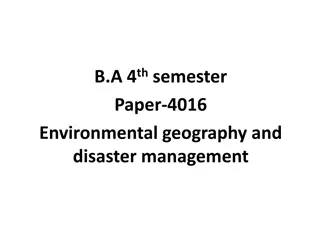Exploring Geography: Unveiling Mysteries of Ancient Landscapes
Delve into the world of geography through the lens of Primary Geography Detectives and embark on a journey to uncover the secrets of ancient sites like Pentre Ifan and Stonehenge. Engage in thought-provoking questions, map explorations, and geological investigations to deepen your understanding of our planet's history and natural wonders.
Download Presentation

Please find below an Image/Link to download the presentation.
The content on the website is provided AS IS for your information and personal use only. It may not be sold, licensed, or shared on other websites without obtaining consent from the author. Download presentation by click this link. If you encounter any issues during the download, it is possible that the publisher has removed the file from their server.
E N D
Presentation Transcript
Primary Geography Geography Detectives: using the front cover Summer 2024 Paula Owens
Starting an enquiry Which are the best geographical questions to ask? What do we need to know to find out more? Has anyone seen this before or something like it?
What is it? What can we see? What can we recognise? What can we label or name? What is it made from? Is it a natural or man made feature? What is it for?
Fact or Opinion? This is what remains of a Neolithic tomb. It is a chambered tomb that would originally have been covered with an earthen mound. A giant 16 ft/5m capstone appears to be precariously balanced on three uprights , though it has remained in place for over 5,000 years. Vocabulary Capstone Chambered Neolithic Precarious Pentre Ifan s sense of mystery is heightened by its surroundings Source: https://cadw.gov.wales/visit/places-to-visit/pentre-ifan-chambered-tomb
Where is Pentre Ifan? Carn Ingli It s near the Preseli Hills. The peak you can see through the stones is a little mountain called Carn Ingli. The Grid Reference is SN 099 370 Can you find it on an Ordnance Survey (OS) map or by using www.digimapforschools.edina.ac.uk?
What is this place like? Can you find and label: Pentre Ifan Carn Ingli Preseli Hills TIP Try zooming in and out of the map.
Bluestones These stones are said to be from the same source as some of those used to create Stonehenge. They are often called Bluestones . Why do you think this is? What do you think this rock is like to touch? Why do you think these stones would have been used? https://www.bgs.ac.uk/map-viewers/bgs-geology-viewer/
Bluestones The term bluestone can be applied to many different rocks. In 2011, a megalithic bluestone quarry was discovered at a site in South West Wales known as Craig Rhos-y-felin. It has been suggested as the source of the Stonehenge bluestones. One theory is that the bluestones were taken to the Stonehenge site from Wales by humans. How far would this have been? Can you estimate it using a map? How might people in neolithic times have moved these rocks? https://blog.geolsoc.org.uk/2016/11/18/the-mystery-of-stonehenges-bluestones
Cadw Cadw is the Welsh Government s historic environment service. Cadw is a Welsh word meaning to keep or to protect . Try saying Cadw : CAD OO Why do you think CADW is a good name for the historic environment service in Wales? Explore other historic sites near you. What is the equivalent of Cadw in Northern Ireland, Scotland and England? https://cadw.gov.wales/about-us
Teacher Notes Slide 1. Ask children to get into geography detective mode. They will need to be thinking like geographers, asking questions like geographers, seeking geographical evidence, and sharing it like a geographer. 2. Discuss geographical questions. Find out what children already know. 3. Use these prompts to explore the image as a class to see if there are any clues there. 4. The text is taken from the official website of CADW. Discuss fact and opinion and ask children to sort and separate the statements. Identify those that aren t clear. Discuss what the facts are telling us about this site. Which ones are most impressive? Is the source (CADW) to be trusted? Why do you think this? Discuss the vocabulary and meaning. You could make a glossary. 5. Watch the short animation which shows how it might have once looked. How does the earth covering help explain how the capstone was put in place? Why is the earth no longer there? Discuss erosion. You could also explore the site using Google Earth. 6. Where is it? Get children to guess using the place names and tell them it is in the UK. Use digital tools such as Digimap for Schools to identify, locate and label the burial site. Develop map skills by exploring the nearby terrain. Use aerial as well as normal map views. If using Digimap, try the historic layers too to investigate more recent changes. Carn Ingli is linked to a web site giving more information about this part of Wales. 7 & 8. Create, compare and discuss maps produced. What kind of place is it? Use the Geograph for Schools layer to investigate images. What might it have been like to live there in the past? How much change has taken place? The physical geography has changed very little though farming practice and settlement has changed in type and size. There are many other clues to prehistoric sites on the map. 9. Investigate the term geology https://www.bgs.ac.uk/map-viewers/bgs-geology-viewer/ Can you find out more about this kind of Bluestone and where it might have been quarried? 10. Use a map search to help you find the quarry and Stonehenge and roughly calculate the distance between the Preseli Hills in SW Wales and Stonehenge. Discuss how the stones might have been moved by humans 11. Discuss who looks after these places and whether it is a good idea or not to preserve the past.























